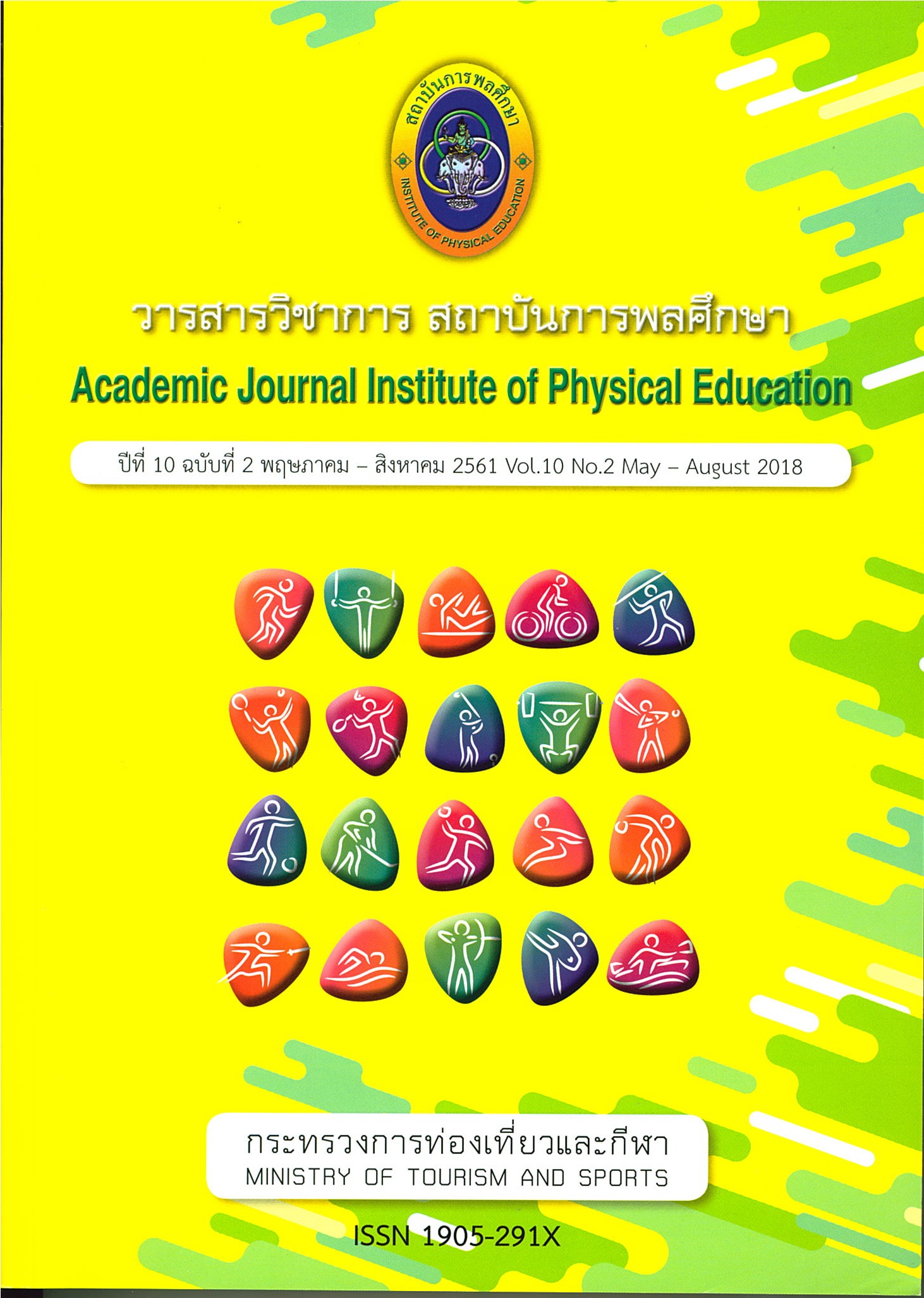The Development of Thinking Levels of Chemical Activity Packages in Chemical Reaction
Main Article Content
Abstract
The purposes of this study were 1) to develop proper chemical learning activity, focusing on Chemical Reaction, 2) to compare outcome of each Chemical Reaction learning activity, 3) to study students’ satisfaction on Chemical Reaction learning activity. The sample group was 25 freshman students, purposively drawn from the Institute of Physical Education, Chonburi Campus, who registered for Chemical Introduction class as a mandatory.The materials used were1) the Chemical learning activity on Chemical Reaction, 2) the Chemical Reaction test, and 3) the questionnaire on the chemical learning satisfaction. The study showed that 1) the effectiveness of process/outcome of the chemical learning activity was 78.6/79.2 which a higher than the average of 75/75, 2) the students, experienced the Chemical Reaction learning activity, achieve their academic goal at the level of statistical significance at p<0.05, 3) the average satisfaction of the students was 4.43 + 0.46
Article Details
The published article is a copyright of the Academic Journal of Thailand National Sports University. The passage appeared in each article in this academic journal is a perspective of each author which is not related to the journal. Each author is required to be responsible for all components of his/her own article. If there are any mistakes, each author must be responsible for those mistakes on his/her own.
References
น้ำฝน คูเจริญไพศาล. (2556). การพัฒนาชุดกิจกรรมวิทยาศาสตร์ เรื่องสารชีวโมเลกุลสำหรับนักเรียนระดับชั้นมัธยมศึกษาตอนปลาย. วิทยานิพนธ์ปริญญาวิทยาศาสตรมหาบัณฑิต. มหาวิทยาลัยศรีนครินทรวิโรฒ.
นินนาท์ จันทร์สูรย์. (2553). การศึกษาการอธิบายปรากฏการณ์ทางเคมี 3 ระดับของผู้เรียนเคมี. คณะวิทยาศาสตร์. มหาวิทยาลัยทักษิณ.
บุญเกื้อ ควรหาเวช. (2542). นวัตกรรมทางการศึกษา. (พิมพ์ครั้งที่ 4). กรุงเทพฯ: SR printing.
สมจิต สวธนไพบูลย์, สายพิณ กิจจา, (2550). การวิจัยและพัฒนาชุดกิจกรรมการจัดการกระบวนการเรียนรู้ที่เน้นผู้เรียนเป็นสำคัญด้วยกิจกรรมหลากหลาย. ศูนย์วิทยาศาสตร์ศึกษา. มหาวิทยาลัยศรีนครินทรวิโรฒ.
ฮามีด๊ะ มูสอ. (2555). การพัฒนาแบบจำลองความคิดเรื่อง กรด-เบส ของนักเรียนชั้นมัธยมศึกษาปีที่ 5 ด้วยกิจกรรมการเรียนรู้โดยใช้แบบจำลองเป็นฐาน. วิทยานิพนธ์ ปริญญาการศึกษามหาบัณฑิต. มหาวิทยาลัยเกษตรศาสตร์.
Chiu, M.H.and W.N.Lin. (2007).Exploring the characteristics and diverse sources of students’ mental models of acids and bases. International Journal of Science Education. 29(6): 771-803.
Coll,R.K. (1999).Learners’ mental models of chemical bonding. Thesis of Doctor Degree: Curtin University of Technology.
Gentner, D. and A. Stevens (eds). (1983). Mental Models, Hillsdale, NJ: Erlbaum.
Gilbert, J.K. (2005). Visualization in Sciennce Education. Netherlands: Springer.
Good. (1973). Dictionary of Education. (3rd) New York: McGraw-Hill.
Harrison, A. G.and D.F.Treagust. (1996).Seconclary students’ mental models of atoms and molecules: Implications for teaching chemistry. Science Education. 80(5): 509-534.
Harrison, A. G. and D. F. Treagust. (2006). Teaching and learning with analogies. In P. J.
Justi, R. and J. Gilbert (2002). Models and modeling in chemical education.In J.K. Chemical education: Towards research-based practice. Boston: Kluwer Academic Publishers: 47-68.
Norman, D.A. (1983). Some observations on mental models. In D. Gentner and A.L. Stevens (eds.), Mental Models. Hillsdale, NJ: Erlbaum.


